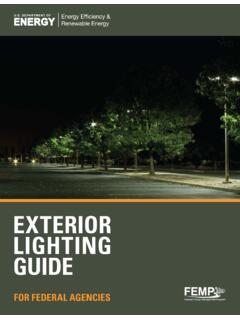Transcription of ADAPTIVE LED STREET & AREA LIGHTING
1 EXTERIOR LIGHTING BUSINESS CASE. ADAPTIVE LED streetlights with motion sensors and network controls line Old Davis Road near the UC Davis Robert Mondavi Institute for Wine and Food Science. ADAPTIVE LED STREET & area LIGHTING . Selecting, financing and implementing best-practice solutions ENERGY & UC Davis, UC Irvine, UC Santa Barbara, and CSU Fullerton have already CO2E SAVINGS invested in ADAPTIVE roadway and area LIGHTING , saving energy and cutting electricity costs. Using occupancy sensors and LIGHTING controls, ADAPTIVE 72 93 % LIGHTING automatically brightens when occupants approach and dims when spaces are vacant, reducing energy use without compromising safety. Network control systems make monitoring, adjusting and maintaining light fixtures easier. OCCUPANCY RATE. This business case provides an economic analysis of different control 20 % options for LED fixtures.
2 It looks at two levels of ADAPTIVE LIGHTING control: local and networked. Both can achieve energy savings beyond 2013 Title 24 requirements, compared to an ADAPTIVE HID source capable of meeting code requirements. Large-scale LIGHTING upgrades generally yield the biggest energy savings, and they qualify for the biggest incentives. The UC / CSU / IOU Energy Efficiency Partnership Incentive Program provides incentives to UC and CSU campuses undertaking energy efficiency projects. Incentives are based on the number of kilowatt-hours (kWh) that projects save beyond Title 24 standards. Combining Partnership incentives with on-bill financing from an investor-owned utility (IOU) or a UC Statewide Energy Partnership loan results in a positive net cash flow for each LIGHTING retrofit option analyzed in this business case.
3 For more information, visit A SMART INVESTMENT. Facility managers have a variety of choices when selecting Networked systems can also monitor energy use which projects to pursue. Funding and bandwidth are limited. and automatically issue maintenance alerts when an So, why devote resources to outdoor LIGHTING upgrades? outage occurs, and they can interface with any building management system currently installed. California's State Partnership for Energy Efficient Demonstrations (SPEED) program has conducted a number of case studies on ADAPTIVE outdoor LIGHTING STREET AND area . retrofits. These studies measured nighttime occupancy LIGHTING SCENARIOS. rates of 15 40 % on university campuses, indicating a The following scenarios are specific examples of local, or tremendous opportunity to reduce energy use and energy fixture-integrated, and networked outdoor LIGHTING control costs while lowering light pollution levels and maintenance solutions.
4 These technology combinations have been costs, too. vetted through real-world SPEED demonstrations, and all Undertaking exterior LIGHTING retrofits on a large, support compliance with control requirements specified campus-wide scale maximizes energy and cost savings by 2013 Title 24, Part 6 (Section (c)) of California's (72 93 %), helping campuses meet their sustainability energy efficiency standards for certain applications. goals. Campus-wide retrofits also allow project planners Title 24, Part 6 specifies different requirements for STREET to optimize LIGHTING designs and select better controls, or area LIGHTING . LIGHTING for public streets and roadways maximizing utility incentives and lowering first costs. is exempt from certain Title 24 requirements. For area lights, where the bottom of the fixture head is mounted CONTROL STRATEGIES FOR at 24' above the ground or lower, a motion sensor or other ADAPTIVE STREET & area LIGHTING occupancy-based control (either local or networked) is required, in addition to a photocontrol or astronomical Most current solutions use passive infrared (PIR).
5 Time switch and an automatic scheduling control. The occupancy sensors paired with dimming lamps and occupancy-sensitive LIGHTING control must be able to ballasts or drivers, for LED fixtures. Networked systems automatically reduce LIGHTING power 40 80 % when no take these smart fixtures with integrated controls occupant is detected. and incorporate them into a mesh network using radio frequency (RF) modules and control software. The per-fixture energy and cost savings for the STREET and area retrofit scenarios presented in this business For the purposes of this business case analysis, the SPEED. case were calculated by comparing the performance team focused on these two major control strategies: specifications of a Cree XSP LED fixture with those of FIXTURE-INTEGRATED CONTROLS: One occupancy sensor a common 150 W metal halide cobrahead fixture.
6 Other is installed per fixture, allowing individual lights to operate manufacturers also offer LED fixtures with 0 10 V. in high or low mode based on occupancy. Tuning fixtures dimming drivers that can achieve similar energy savings to 30% of full LIGHTING power in low mode, versus 50 %, and are available in a range of styles and costs. for example, results in deeper energy savings. With post-top fixtures, networked ADAPTIVE LED. NETWORK CONTROLS: Networked LIGHTING systems offer technology is significantly more cost effective in new a more sophisticated level of LIGHTING control. Occupancy construction projects, versus retrofits. For this reason, sensors and wireless control modules connected to the energy savings calculations for post-top fixtures are light fixtures communicate with a gateway, a central presented in comparison to ADAPTIVE HID fixtures control point for the network.
7 Using network control that comply with 2013 Title 24 requirements for new software and Internet access, facility personnel can issue installations. The LED example used is the Lumec signals through the gateway(s) to program, monitor and EcoSwap LED fixture with fixture-level and network adjust the LIGHTING system, controlling individual fixtures, controls. The HID alternative used for comparison is a groups of fixtures, or the entire network. 150 W HID fixture with fixture-integrated controls. 2 | SPEED PROGRAM BUSINESS CASE. Networked ADAPTIVE LIGHTING along Old Davis Road on the UC Davis campus. ENERGY SAVINGS BEYOND 2013 TITLE 24, PART 6 REQUIREMENTS. ADAPTIVE LED + NETWORK CONTROLS. LED + LED +. ADAPTIVE Network Network 80 % ENERGY SAVINGS. LED LED Controls Controls LED fixtures equipped with Lumewave network controls STREET dim throughout the night as occupancy rates decrease.
8 Good Better Better Best This curfew dimming is set to a schedule and is not LIGHTING dynamic. This scenario works well in spaces with limited area & hours of use and very low evening occupancy rates. Non- Post-Top Good Better Best compliant LIGHTING ADAPTIVE LED + NETWORK CONTROLS. LED (without controls) 91 % ENERGY SAVINGS. This scenario utilizes LED fixtures combined with 72 % ENERGY SAVINGS. Lumewave network controls and fixture-integrated This most basic scenario consists of retrofitting an LED occupancy sensors. This allows the fixtures to dim fixture with a photocontrol or timeclock controlling the based on a schedule set through the network (curfew fixture. Note: This is in compliance with Title 24 for dimming) and in response to vacant periods (occupancy- STREET LIGHTING , but other hardscape LIGHTING must also be based dimming).
9 This solution is effective in areas where equipped with automatic scheduling controls and motion occupancy patterns vary. sensors. NEW CONSTRUCTION POST-TOP: ADAPTIVE LED: ADAPTIVE LED + NETWORK CONTROLS. LED + LOCAL CONTROLS (100 % / 20 %). 93 % ENERGY SAVINGS. 88 % ENERGY SAVINGS. Like the scenario just described, the post-top scenario This scenario adds local controls to the same LED utilizes an LED light source, fixture-level occupancy fixtures just described. A time clock or photocontrol sensors and Lumewave network controls. Unlike all the turns the fixture off at dawn and on at dusk. WattStopper other scenarios described in this business case, the fixture-integrated PIR sensors then allow the fixtures calculations presented for post-top fixtures reflect costs to operate in high mode (100 %) when the space and benefits associated with new construction not is occupied and dim to 20% when it is vacant.
10 This retrofitting. This is because decorative post-tops are dynamic, tailored approach to LIGHTING makes it a good fit less cost-effective to retrofit than other STREET and area for spaces with irregular occupancy patterns. light fixtures, but as part of a new construction plan, maximizing post-tops' efficiency makes good economic sense (see page 11 for more information). ADAPTIVE STREET & area LIGHTING | 3. COST, SAVINGS & INCENTIVES. PROJECT COSTS UC / CSU / IOU ENERGY EFFICIENCY. Table 1 lists project costs per fixture for each of the PARTNERSHIP INCENTIVES. scenarios just described. These costs include all materials The UC and CSU campuses have a multi-year partnership for the system (fixtures, sensors, gateways, and any with California's investor-owned utilities (IOUs). Through other related materials), as well as the cost of labor this partnership campuses provide energy savings to help ($ 65 per hour) for installation and an additional 20 % utilities meet their goals, and utilities provide Partnership for construction management (CM).








